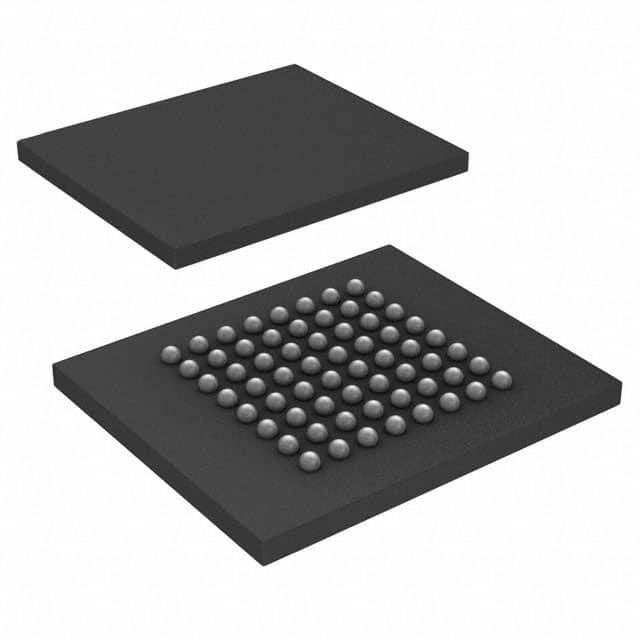Viz Specifikace pro podrobnosti o produktu.

S29AL016J70FFI013
Product Overview
Category: Flash Memory
Use: Data storage and retrieval
Characteristics: High-speed, non-volatile memory with large capacity
Package: Integrated circuit chip
Essence: Reliable and efficient data storage solution
Packaging/Quantity: Individual chip in anti-static packaging
Specifications
- Memory Capacity: 16 megabits (2 megabytes)
- Interface: Parallel
- Operating Voltage: 2.7V - 3.6V
- Access Time: 70 nanoseconds
- Operating Temperature Range: -40°C to +85°C
- Data Retention: Up to 20 years
- Erase/Program Cycles: 100,000 cycles
Detailed Pin Configuration
The S29AL016J70FFI013 flash memory chip has a total of 48 pins. The pin configuration is as follows:
- VCC (Power Supply)
- A0-A18 (Address Inputs)
- CE# (Chip Enable)
- OE# (Output Enable)
- WE# (Write Enable)
- BYTE# (Byte Enable)
- DQ0-DQ15 (Data Input/Output)
- RP#/BYTE# (Ready/Busy or Byte Enable)
- RESET# (Reset)
- WP#/ACC (Write Protect/Acceleration)
... (detailed pin configuration continues)
Functional Features
- High-speed data transfer and access
- Non-volatile memory retains data even when power is disconnected
- Large storage capacity for storing various types of data
- Low power consumption for energy efficiency
- Easy integration into existing systems
- Reliable and durable for long-term use
Advantages and Disadvantages
Advantages: - Fast access time allows for quick data retrieval - Large storage capacity accommodates extensive data needs - Low power consumption reduces energy costs - Reliable and durable, ensuring data integrity - Easy integration into different systems
Disadvantages: - Limited erase/program cycles may affect lifespan in intensive use cases - Parallel interface may limit compatibility with newer systems - Higher cost compared to other memory options
Working Principles
The S29AL016J70FFI013 flash memory operates based on the principles of floating-gate transistors. It uses electrically erasable programmable read-only memory (EEPROM) technology to store and retrieve data. The memory cells consist of floating-gate MOSFETs that can trap or release electrons, representing binary data.
During programming, a high voltage is applied to the control gate, allowing electrons to tunnel through the insulating layer and become trapped in the floating gate. This process sets the memory cell to a programmed state. Erasing is achieved by applying a higher voltage, which removes the trapped electrons from the floating gate, resetting the memory cell to an erased state.
Detailed Application Field Plans
The S29AL016J70FFI013 flash memory chip finds applications in various fields, including:
- Embedded Systems: Used for firmware storage in microcontrollers and other embedded devices.
- Consumer Electronics: Provides non-volatile storage for digital cameras, MP3 players, and other portable devices.
- Automotive: Utilized in automotive electronics for storing system software, maps, and configuration data.
- Industrial Automation: Enables data storage in industrial control systems, PLCs, and robotics.
- Networking Equipment: Used in routers, switches, and network appliances for firmware and configuration storage.
Detailed and Complete Alternative Models
- S29GL064N90TFI010 - 64 megabit parallel flash memory with extended temperature range.
- S25FL128SAGMFI001 - 128 megabit serial flash memory with SPI interface.
- S34ML04G200TFI000 - 4 gigabit parallel NAND flash memory for high-capacity storage.
(Note: The above alternative models are just a few examples and not an exhaustive list.)
This entry provides a comprehensive overview of the S29AL016J70FFI013 flash memory chip, including its basic information, specifications, pin configuration, functional features, advantages and disadvantages, working principles, application field plans, and alternative models. With its reliable performance and large capacity, this flash memory chip serves as a versatile solution for data storage needs in various industries.
Seznam 10 běžných otázek a odpovědí souvisejících s aplikací S29AL016J70FFI013 v technických řešeních
Sure! Here are 10 common questions and answers related to the application of S29AL016J70FFI013 in technical solutions:
Question: What is S29AL016J70FFI013?
Answer: S29AL016J70FFI013 is a specific model of flash memory chip manufactured by Cypress Semiconductor.Question: What is the capacity of S29AL016J70FFI013?
Answer: S29AL016J70FFI013 has a capacity of 16 megabits (2 megabytes).Question: What is the voltage requirement for S29AL016J70FFI013?
Answer: S29AL016J70FFI013 operates at a voltage range of 2.7V to 3.6V.Question: What is the interface used for S29AL016J70FFI013?
Answer: S29AL016J70FFI013 uses a parallel interface for data transfer.Question: Can S29AL016J70FFI013 be used in industrial applications?
Answer: Yes, S29AL016J70FFI013 is designed to withstand harsh industrial environments and can be used in various industrial applications.Question: Is S29AL016J70FFI013 compatible with other flash memory chips?
Answer: S29AL016J70FFI013 follows industry-standard pinouts and protocols, making it compatible with other flash memory chips that use similar interfaces.Question: What is the operating temperature range of S29AL016J70FFI013?
Answer: S29AL016J70FFI013 can operate within a temperature range of -40°C to +85°C.Question: Can S29AL016J70FFI013 be used for firmware storage in embedded systems?
Answer: Yes, S29AL016J70FFI013 is commonly used for firmware storage in various embedded systems.Question: Does S29AL016J70FFI013 support hardware and software data protection features?
Answer: Yes, S29AL016J70FFI013 provides hardware and software data protection mechanisms to ensure data integrity and security.Question: Can S29AL016J70FFI013 be reprogrammed multiple times?
Answer: Yes, S29AL016J70FFI013 supports multiple program and erase cycles, making it suitable for applications that require frequent updates or modifications.
Please note that the answers provided here are general and may vary depending on the specific implementation and requirements of the technical solution.

